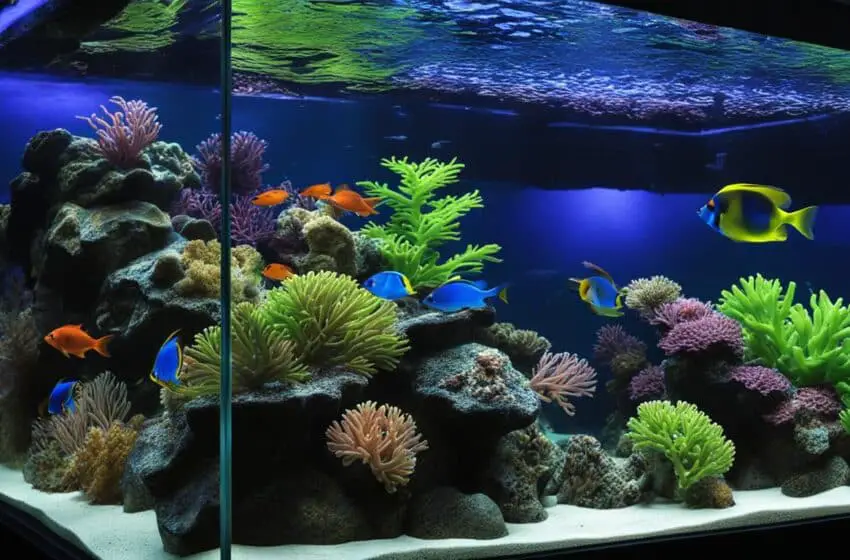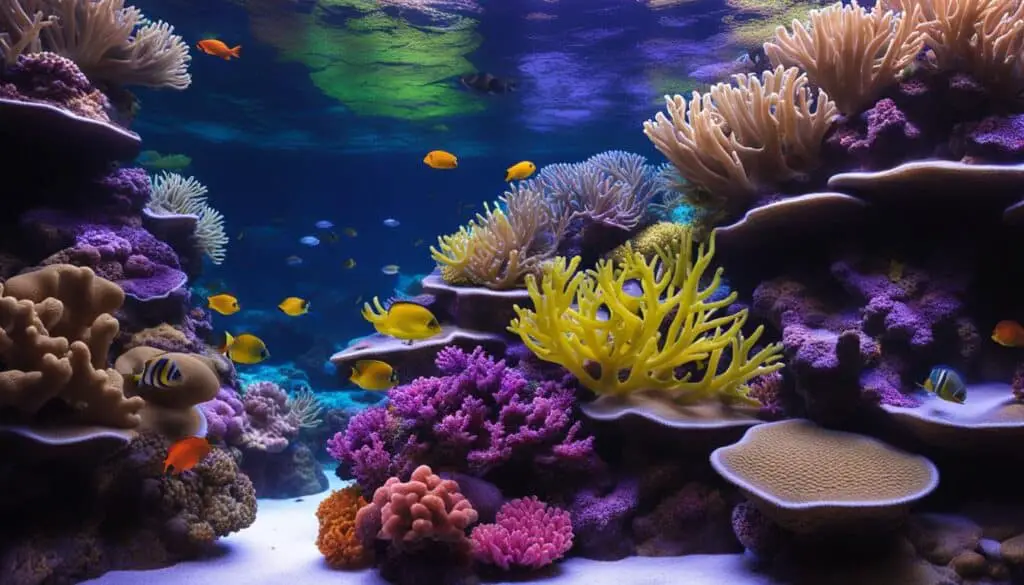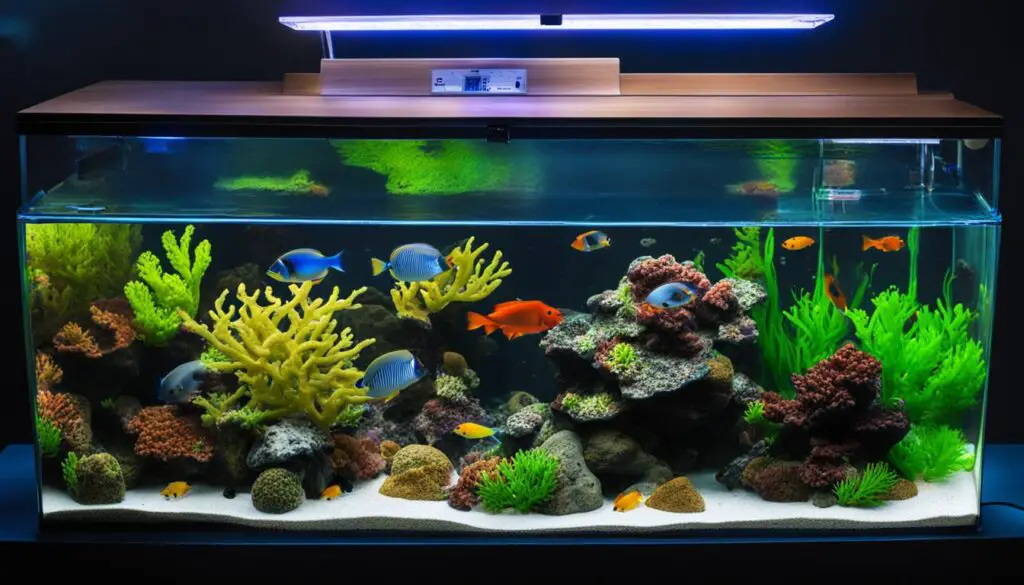Saltwater Aquarium Lighting Guide

When it comes to setting up a saltwater aquarium, lighting plays a crucial role in creating the optimal environment for different types of organisms. The lighting requirements vary depending on the type of aquarium, whether it is a fish-only tank, a fish-only with live rock (FOWLR) tank, or a reef tank with corals.
Fish-only tanks require limited lighting for the fish’s visibility, while FOWLR tanks need more lighting for live rock and invertebrates. Reef tanks, which house corals, anemones, and other invertebrates, have the highest lighting requirements. Different corals have different lighting needs, with some requiring high light intensity for growth and reproduction.
Key Takeaways:
- Fish-only tanks require limited lighting for fish visibility.
- FOWLR tanks need more lighting for live rock and invertebrates.
- Reef tanks have the highest lighting requirements due to the presence of corals.
- Different corals have different lighting needs.
- Proper lighting is essential for maintaining a healthy saltwater aquarium.
Lighting for Fish-Only Aquariums
When it comes to fish-only aquariums, the lighting serves a primary purpose of visual enjoyment. The fish in these tanks do not require intense lighting, as their visibility needs are relatively limited. To create a comfortable lighting environment, a timer-controlled light fixture that mimics the natural transition from dawn to dusk is recommended.
One advantage of using a timer-controlled light fixture is that it can provide a gradual light transition. The lighting gradually turns on in the morning, simulating the rising sun, and gradually dims at night to mimic the setting sun. This gradual light transition helps to maintain a natural lighting cycle for the fish.
In fish-only tanks, crustacean invertebrates and snails have minimal lighting requirements. Many of these creatures are nocturnal, and excessive lighting can disrupt their natural behavior. Therefore, it is important to provide limited lighting to cater to their specific needs.
Overall, Fish-only tank lighting should be designed to enhance the visual appeal of the aquarium without overwhelming the fish or disturbing the natural behaviors of other tank inhabitants.
| Lighting Recommendations for Fish-Only Aquariums | Benefits |
|---|---|
| Use a timer-controlled light fixture | – Mimics natural lighting cycles – Provides gradual light transition |
| Opt for limited lighting | – Avoids overwhelming the fish – Preserves natural behaviors of nocturnal creatures |
Lighting for Fish-Only With Live Rock (FOWLR) Aquariums
In FOWLR aquariums, lighting plays a crucial role in supporting the diverse organisms living within, including live rock, invertebrates, and macroalgae. These tanks require higher lighting compared to fish-only tanks to provide the necessary conditions for growth and vitality. Additionally, light is essential for coralline algae growth, which adds a vibrant and natural aesthetic to the tank.
When it comes to lighting options for FOWLR tanks, fluorescent lights have been widely used and proven effective. However, energy-efficient LED lights have gained popularity due to their lower operating costs and versatility in providing the ideal light intensity and spectrum.
To ensure the right lighting environment for your FOWLR tank, it is essential to consider the specific needs of the organisms within it. Invertebrates, such as polyps and macroalgae, rely on light for photosynthesis and growth. By providing adequate lighting, you create a thriving ecosystem that mimics the natural conditions of the ocean.
Here is a comparison table of different lighting options for FOWLR tanks:
| Lighting Option | Features | Benefits |
|---|---|---|
| Fluorescent Lights | – Wide availability – Affordable – Suitable for most FOWLR tanks | – Established track record – Adequate lighting for many organisms |
| LED Lights | – Energy-efficient – Adjustable intensity – Versatile lighting options | – Lower operating costs – Customizable lighting environment |
With the right lighting setup, you can maximize the growth and vitality of the organisms in your FOWLR tank, creating a visually stunning and thriving marine ecosystem.
Lighting for Reef Tanks
Reef tanks, with their extensive coral and invertebrate populations, have the highest lighting requirements. Different corals have varying lighting needs based on their species and growth patterns. It is crucial to understand these requirements to provide the optimal lighting conditions for the corals in your reef tank.
Soft corals, such as mushrooms and zoanthids, generally require less intense light compared to hard corals like LPS (Large Polyp Stony) corals and SPS (Small Polyp Stony) corals. Soft corals typically thrive in moderate to low light conditions, while hard corals require higher light intensity for proper growth and reproduction.
To meet the lighting needs of corals in a reef tank, it is essential to choose the right type of lighting fixtures. In the past, fluorescent lights were commonly used for coral growth. However, LED lights have become the preferred choice among reef enthusiasts due to their efficiency and ability to provide the necessary light intensity and spectrum.
LED lights offer several advantages for reef tank lighting:
- Energy Efficiency: LED lights consume less power compared to fluorescent lights, resulting in lower operating costs and reduced energy consumption.
- Adjustable Intensity: Many LED light fixtures allow users to adjust the light intensity, making it easier to meet the specific lighting requirements of different coral species.
- Spectrum Control: LED lights can provide a customizable spectrum of light, allowing reef keepers to mimic natural lighting conditions and enhance coral growth.
- Long Lifespan: LED lights have a significantly longer lifespan compared to fluorescent lights, reducing the need for frequent bulb replacements.
When selecting LED lights for your reef tank, consider factors such as the size of your tank, the types of corals you plan to keep, and your budget. It’s also crucial to position the lights correctly to ensure uniform coverage and prevent shading, which can hinder coral growth.
Overall, providing the right lighting conditions is crucial for the health and growth of corals in a reef tank. By understanding the different coral lighting requirements and utilizing suitable lighting fixtures, you can create an optimal environment that promotes vibrant and thriving coral colonies.

Safety Measures for Aquarium Lighting
Safety is paramount when dealing with electrical equipment in saltwater tanks. Unlike freshwater tanks, saltwater tanks have readily flowing electrical current, making safety measures crucial. To ensure the well-being of your aquatic life and prevent accidents, it’s essential to take the necessary precautions.
1. Dedicated Electrical Circuit
Each aquarium should have its own dedicated electrical circuit to avoid overloading the system. This prevents power fluctuations and reduces the risk of electrical hazards. By isolating the electrical supply for your tank, you can better control and monitor the electricity flowing into the aquarium.
2. Ground Fault Circuit Interrupter (GFCI) Outlets
A Ground Fault Circuit Interrupter (GFCI) outlet is a critical safety component for saltwater tanks. GFCI outlets are designed to quickly detect imbalances in current flow and interrupt the circuit, preventing electric shock and reducing the risk of electrical fire.
“GFCI outlets offer an added layer of protection by monitoring the current and shutting off the power if a fault is detected. These outlets are essential for any saltwater aquarium setup.”
3. Proper Organization of Electrical Equipment
Organizing electrical equipment is crucial for safety and ease of maintenance. Keep all electrical cords organized and secured to prevent tangling, tripping, or accidental damage. Use cable clips or cable management systems to keep the cords neatly arranged and out of the way. Additionally, ensure that the cords are away from water sources to minimize the risk of electrical accidents.
4. Surge Protectors
Investing in surge protectors is a smart choice for protecting your aquarium equipment from power surges. Surges can be caused by lightning strikes, electrical faults, or utility company voltage irregularities. A surge protector will help safeguard your electrical equipment, preventing damage and potential hazards.
5. Preventing Saltwater Exposure to Equipment
Saltwater is corrosive, and exposure to electrical equipment can lead to deterioration and increased safety risks. Take measures to shield your electrical components from saltwater exposure, such as enclosing them in waterproof enclosures or keeping them above the waterline. Regularly inspect the equipment for any signs of corrosion and replace or repair as necessary.
By following these safety measures, you will create a secure and reliable electrical setup for your saltwater aquarium, ensuring the well-being of your aquatic inhabitants and providing peace of mind for you as an aquarium enthusiast.

Preventing Electrical Accidents
In addition to the safety measures discussed earlier, there are a few more precautions you should take to prevent electrical accidents in your saltwater aquarium.
- Use Drip Loops: When setting up your aquarium’s electrical equipment, make sure to use drip loops on power cords. Drip loops are loops of cable that hang below the level of electrical outlets, preventing water from dripping directly into the outlets and reducing the risk of electrical shock. This simple step can help safeguard both you and your marine life.
- Turn Off Equipment: Before placing your hands in the tank or performing any maintenance tasks, always remember to turn off all equipment that poses a risk of electric shock. This includes pumps, heaters, and any other electrical devices that are in or near the water. Taking this precaution will minimize the potential for accidents and keep you safe.
- Wear Rubber-Soled Shoes: Another way to add an extra layer of protection against electrical accidents is to wear rubber-soled shoes when working with your aquarium. Rubber is a good insulator and can help prevent the conduction of electric current through your body, reducing the risk of electric shock.
- Limit Use of Extension Cords: While extension cords may seem convenient, they should only be used for temporary purposes in your saltwater aquarium. Using extension cords as a permanent solution can increase the risk of electrical accidents, especially if they are not rated for aquarium use. Whenever possible, try to plug your equipment directly into dedicated outlets.
- Organize Power Cords: Keeping your power cords organized and secured can go a long way in preventing accidents. Avoid loose cords and ensure they are properly bundled or secured to prevent tripping hazards. Utilizing cable management solutions can help keep your aquarium area clean and tidy, minimizing the risk of accidental damage or injury.
- Shield Electronic Equipment: It’s important to shield any electronic equipment in your saltwater aquarium from exposure to saltwater. Saltwater is corrosive and can cause damage to sensitive electrical components, increasing the risk of malfunctions and accidents. Make sure to use appropriate enclosures or housings to protect your equipment.
By following these additional precautions, you can create a safer environment for both yourself and your marine life, preventing electrical accidents and ensuring a smooth and enjoyable saltwater aquarium experience.
Conclusion
Proper lighting is crucial for creating a healthy and visually stunning saltwater aquarium. Understanding the unique lighting requirements for different tank types, implementing safety measures, and organizing your electrical equipment are essential for success. Whether you have a fish-only tank, a fish-only with live rock (FOWLR) tank, or a reef tank, each type demands specific lighting conditions to meet the needs of the organisms residing within it.
By following the guidelines outlined in this saltwater aquarium lighting guide, you can ensure that your marine life thrives in a safe and optimal lighting environment. Remember that fish-only tanks primarily require lighting for visual enjoyment, while FOWLR tanks necessitate more lighting for live rock and invertebrates. In contrast, reef tanks, with their diverse coral and invertebrate populations, require the highest lighting requirements.
To maintain both the health of your marine life and your own safety, it is essential to adhere to safety measures when dealing with aquarium lighting. Each aquarium should have its dedicated electrical circuit and be equipped with a ground fault circuit interrupter (GFCI) outlet. Additionally, proper organization of electrical equipment, the use of surge protectors, and preventing saltwater exposure to equipment are critical for avoiding accidents and ensuring the longevity of your lighting setup.
FAQ
What is the role of lighting in a saltwater aquarium?
Lighting plays a crucial role in creating the optimal environment for different types of organisms in a saltwater aquarium. It varies depending on the type of aquarium, whether it is a fish-only tank, a fish-only with live rock (FOWLR) tank, or a reef tank with corals.
What are the lighting requirements for fish-only aquariums?
Fish-only tanks require limited lighting for the fish’s visibility. Timer-controlled light fixtures that mimic dawn-to-dusk lighting are sufficient for visual enjoyment. Some fixtures even offer a gradual light transition.
What lighting is needed for fish-only with live rock (FOWLR) aquariums?
FOWLR tanks require higher lighting than fish-only tanks because of the presence of live rock, invertebrates, and macroalgae. Fluorescent lighting is suitable, but LED lights are increasingly popular due to their efficiency and lower operating cost.
What lighting requirements are there for reef tanks?
Reef tanks, with their extensive coral and invertebrate populations, have the highest lighting requirements. Corals have varying lighting needs, with soft corals requiring less intense light compared to hard corals (LPS & SPS). LED lights have become popular due to their efficiency and ability to provide the necessary light intensity and spectrum.
What safety measures should I consider for aquarium lighting?
Safety is paramount when dealing with electrical equipment in saltwater tanks. Each aquarium should have its own dedicated electrical circuit and a ground fault circuit interrupter (GFCI) outlet. Proper organization of electrical equipment, use of surge protectors, and prevention of saltwater exposure to equipment are important safety measures.
How can I prevent electrical accidents in my saltwater aquarium?
To prevent electrical accidents, employ drip loops on power cords to prevent water from dripping into electrical inlets. Turn off equipment posing a risk of shock before placing hands in the tank, and wear rubber-soled shoes for added protection. Extension cords should only be used temporarily, and loose cords should be organized. Shield electronic equipment from saltwater exposure to prevent damage.
What key factors should I consider for proper saltwater aquarium lighting?
To maintain a healthy and visually appealing saltwater aquarium, it is essential to understand the lighting requirements for different tank types, implement safety measures, and organize electrical equipment. Each type of tank requires specific lighting conditions to meet the needs of the organisms living within it.



